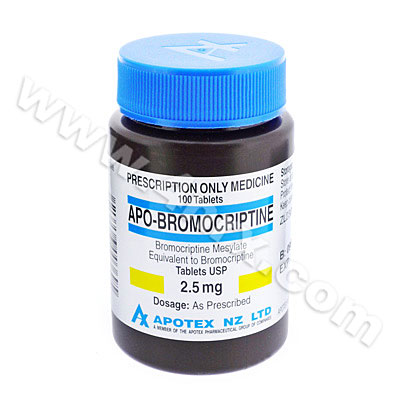| Active Ingredient |
Bromocriptine |
| Manufacturer |
Apotex Pharmaceuticals Ltd. |
| Origin |
New Zealand |
| Other Names |
N/A |
| Reference |
N/A |
How does Apo-Bromocriptine (Bromocriptine) work:
Apo-Bromocriptine (Bromocriptine) is a brominated ergot derivative that functions as a dopamine D2 receptor agonist and a dopamine D1 receptor antagonist. It imposes a direct dopaminergic effect on cells located within the basal ganglia, mesolimbic system and hypothalamus. It does not possess the uterotonic and vasoconstrictive properties associated with other ergot preparations.
Apo-Bromocriptine specifically inhibits the synthesis and secretion of prolactin from the anterior pituitary gland by dopaminergic stimulation of pituitary prolactin cells. Amenorrhoea, galactorrhoea and other endocrine processes associated with hyperprolactinaemia are consequently returned to physiological levels of activity. Bromocriptine also enhances the release of gonadotrophin and gonadal steroids that are suppressed in hyperprolactinaemia. Preclinical studies have reported that bromocriptine decreases dopamine turnover in the median eminence and dopaminergic tubero-infundibular region of the hypothalamus which may further regulate the synthesis and secretion of prolactin.
Apo-Bromocriptine reduces the elevated levels of growth hormone in acromegaly and may alleviate the clinical symptoms and glucose intolerance presented in this condition. The dopaminemimetic activity of bromocriptine in the striatum may be responsible for the beneficial effects observed in selected cases of Parkinson`s Disease.
Dosage & Administration:
Menstrual cycle disorders, Galactorrhoea, Female Infertility:
Usual therapeutic dosage is 5 - 7.5 mg daily in divided doses, but may range from 2.5 - 30mg a day. Initial doses should be low (1.25 - 2.5 mg) and slowly increased at 5 to 7 day intervals, as tolerated. The lowest dose possible, that controls symptoms, should be used. Treatment is continued until menstruation and/or ovulation has normalised.
Pre-menstrual symptoms:
Treatment should begin on the 14th day of the cycle taking 1.25mg a day. Increase the dosage in steps of 1.25mg daily up to 2.5mg twice a day until menstruation begins.
Male hypogonadism:
Initial dosage 1.25mg 2 or 3 times a day gradually increasing to 5 - 10mg a day.
Prolactinomas:
1.25mg 2 or 3 times daily; this can be gradually increased as needed to suppress prolactin secretion.
Acromegaly:
Initially 1.25mg 2 or 3 times a day gradually increasing to 10 - 20mg a day, depending on side effects and clinical response.
Inhibition of lactation:
On day one take 1.25mg morning and night with food, increasing on day two to 2.5 mg twice daily. Therapy should be continued for 14 days to prevent rebound lactation. Treatment should be started as soon as possible after parturition or abortion.
Benign breast disease:
1.25mg 2 - 3 times a day which may be increased to 5 - 7.5mg a day.
Parkinson`s Disease:
Starting doses must be low initially (1.25mg daily), preferably at bedtime, and dosage increases must be gradual e.g. at intervals of 5 - 7 days. Dosages should be individually titrated according to therapeutic response and tolerability and given in 2 - 3 divided doses. If an undesirable reaction occurs, the dosage should be reduced for at least a week. Titration upwards may then be cautiously re-tried. An adequate therapeutic response may be reached in 6 - 8 weeks. When bromocriptine is added to regimens of levodopa where patients are experiencing motor difficulties or side-effects, it is recommended that the dose of levodopa is reduced prior to the addition of bromocriptine. As the dosage of bromocriptine is titrated upwards, the dose of levodopa may be reduced further.
The usual range of bromocriptine when used as monotherapy or as an adjunct to levodopa therapy is 10 - 40 mg a day in divided doses, taken with food.
Hepatic dysfunction:
Dosage may have to be reduced in patients with impaired hepatic function.
Ask your physician if you have any questions on using Apo-Bromocriptine (Bromocriptine).
Side Effects:
- nausea
- vomiting
- dizziness
- postural hypotension
- fainting
- abdominal cramps
- epigastric pain
- indigestion
- constipation
- diarrhoea
- headache
- nasal congestion
- watery rhinorrhoea
- dry mouth
- drowsiness
- psychosis
- nightmares
- anxiety
- mania
- hallucinations
- confusion
- erythromelalgia
- extreme agitation
- paraesthesias
- fatigue
- arrhythmias
- exacerbation of angina
- pulmonary fibrosis
- constrictive pericarditis
- fatal gastric haemorrhage
- hypertension
- myocardial infarction
- seizures
- strokes
- psychiatric disorders
Precautions:
For more detailed warnings and precautions, please see the Data Sheet.

 Milk Supply
Milk Supply  Apo-Bromocriptine (Bromocriptine)
Apo-Bromocriptine (Bromocriptine) 